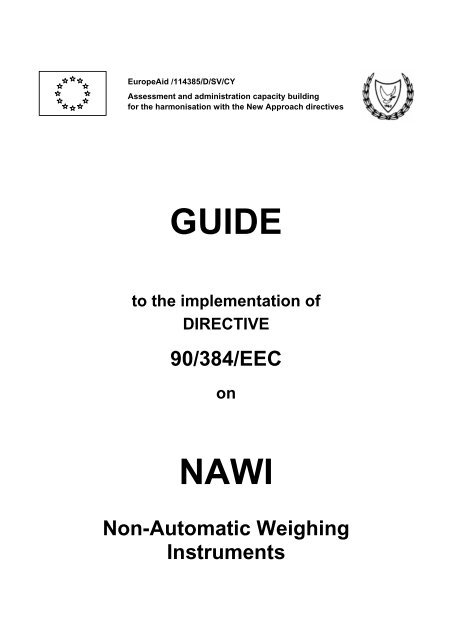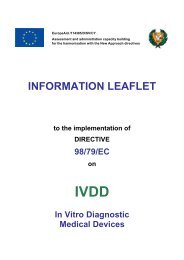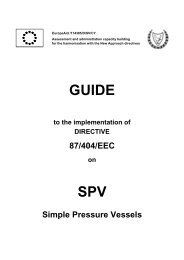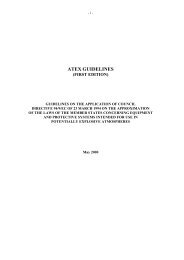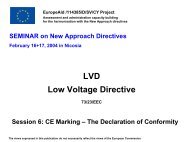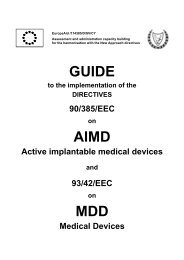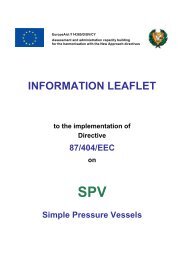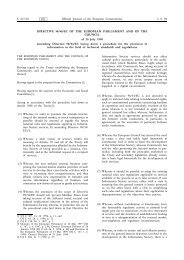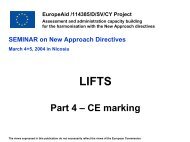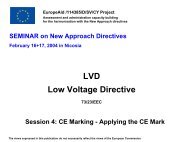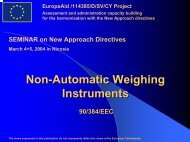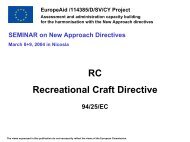GUIDE NAWI - Cyprus Organization for the Promotion of Quality
GUIDE NAWI - Cyprus Organization for the Promotion of Quality
GUIDE NAWI - Cyprus Organization for the Promotion of Quality
You also want an ePaper? Increase the reach of your titles
YUMPU automatically turns print PDFs into web optimized ePapers that Google loves.
EuropeAid /114385/D/SV/CYAssessment and administration capacity building<strong>for</strong> <strong>the</strong> harmonisation with <strong>the</strong> New Approach directives<strong>GUIDE</strong>to <strong>the</strong> implementation <strong>of</strong>DIRECTIVE90/384/EECon<strong>NAWI</strong>Non-Automatic WeighingInstruments
Guide on <strong>NAWI</strong> DirectiveEuropeAid /114385/D/SV/CYFREE MOVEMENT OF GOODSAchieving <strong>the</strong> free movement <strong>of</strong> goods lies at <strong>the</strong> heart <strong>of</strong> achieving an open market <strong>for</strong> business inEurope.In May 1985, European Community Ministers agreed on a ‘New Approach to Technical Harmonisationand Standards’ in order to fulfill this objective.‘New Approach’ Directives (that is Community laws) set out ‘essential requirements’ (<strong>for</strong> safety orprotection, <strong>for</strong> example), written in general terms, which must be met be<strong>for</strong>e products may be placed on<strong>the</strong> market in <strong>the</strong> Community.European Standards fill in <strong>the</strong> detail and are <strong>the</strong> main way <strong>for</strong> businesses to meet <strong>the</strong> ‘essentialrequirements’. The Directives also states how manufacturers are to show that products meet <strong>the</strong> ‘essentialrequirements’. Products meeting <strong>the</strong> requirements are to carry <strong>the</strong> CE marking, which indicates that <strong>the</strong>ycan be sold anywhere in <strong>the</strong> Community.Under <strong>the</strong> European Economic Area (EEA) Agreement <strong>the</strong> provision <strong>of</strong> <strong>the</strong> Directives now additionallyapplies in four <strong>of</strong> <strong>the</strong> Member States <strong>of</strong> <strong>the</strong> European Free Trade Association (EFTA): Norway, Iceland,Switzerland and Liechtenstein.The Non-automatic Weighing Instruments (<strong>NAWI</strong>) Directive 90/384/EEC has been transposed intonational law in <strong>the</strong> Member States and came into <strong>for</strong>ce on 1 January 1993.The Directive provided <strong>for</strong> transitional arrangements <strong>for</strong> a period <strong>of</strong> 10 years (up to 1 January 2003) toallow new instruments to continue to be subject to <strong>the</strong> rules previously in <strong>for</strong>ce.The Amending Directive 93/68/EEC which amended <strong>the</strong> CE Marking provisions <strong>of</strong> a number <strong>of</strong> Directivesincluding <strong>the</strong> <strong>NAWI</strong> Directive provided a 2 year transition <strong>for</strong> those changes from 1 January 1995 to 1January 1997 after which <strong>the</strong> changes became mandatory.
Guide on <strong>NAWI</strong> DirectiveEuropeAid /114385/D/SV/CYBRIEF OVERVIEW OF THE DIRECTIVEENTRY INTO FORCE1 January 1993COVERAGEnon-automatic weighing instruments; that is measuring instruments which determine <strong>the</strong> mass <strong>of</strong> a bodyor o<strong>the</strong>r mass related magnitudes, quantities, parameters or characteristics by using <strong>the</strong> action <strong>of</strong> gravity,and which require <strong>the</strong> intervention <strong>of</strong> an operator.ESSENTIAL REQUIREMENTSInstruments <strong>for</strong> Article 1(2)a applications must satisfy <strong>the</strong> essential requirements set out in Annex I <strong>of</strong> <strong>the</strong>Directive. These are based on Recommendation No 76 <strong>of</strong> <strong>the</strong> International Organisation <strong>of</strong> LegalMetrology (OIML) and include metrological requirements, such as accuracy and units <strong>of</strong> measurement;and design and construction requirements, such as resistance to environmental disturbances.Instruments used <strong>for</strong> o<strong>the</strong>r applications do not have to satisfy <strong>the</strong> essential requirements. Where <strong>the</strong>yhave not undergone any ‘attestation’ procedure, <strong>the</strong>y must not bear <strong>the</strong> CE marking unless <strong>the</strong> CEmarking is affixed as a result <strong>of</strong> compliance with ano<strong>the</strong>r Directive.These instruments must, however, carry <strong>the</strong> manufacturer’s name or mark, and indicate <strong>the</strong>ir maximumcapacity in a clearly visible, easily legible and indelible <strong>for</strong>m.Devices embodied in, or attached to, instruments <strong>for</strong> Article 1(2)a applications that are used <strong>for</strong> suchpurposes do not need to satisfy <strong>the</strong> essential requirements if <strong>the</strong>y are used in accordance with <strong>the</strong>Preliminary Observation in Annex I <strong>of</strong> <strong>the</strong> Directive 1 , but must carry <strong>the</strong> restricted use symbol 2 .METHODS OF SATISFYING THE ESSENTIAL REQUIREMENTSmanufacture in con<strong>for</strong>mity with:• specified harmonised European Standards, which are published in <strong>the</strong> Member States asidentically worded national standards; or• <strong>the</strong> essential requirements.The reference number <strong>of</strong> <strong>the</strong> harmonised European Standard is EN 45501 + AC: 1994.1 Preliminary Observation: Where an instrument includes, or is connected to, more than one indicating orprinting device used <strong>for</strong> Schedule 3 applications, those devices which repeat <strong>the</strong> results <strong>of</strong> <strong>the</strong> weighingoperation and which cannot influence <strong>the</strong> correct functioning <strong>of</strong> <strong>the</strong> instrument shall not be subject to <strong>the</strong>essential requirements if <strong>the</strong> weighing results are printed or recorded correctly and indelibly by a part <strong>of</strong><strong>the</strong> instrument which meets <strong>the</strong> essential requirements and <strong>the</strong> results are accessible to both partiesconcerned by <strong>the</strong> measurement. However, in <strong>the</strong> case <strong>of</strong> instruments used <strong>for</strong> direct sales to <strong>the</strong> public,display and printing devices <strong>for</strong> <strong>the</strong> vendor and <strong>the</strong> customer must fulfil <strong>the</strong> essential requirements.2 Restricted use symbol: a capital letter M printed in black on a red background at least 25 mm x 25 mmsquare with two intersecting diagonals <strong>for</strong>ming a cross, to be affixed in a clearly visible and indelible <strong>for</strong>m.
Guide on <strong>NAWI</strong> DirectiveEuropeAid /114385/D/SV/CYHOW TO SHOW THE ESSENTIAL REQUIREMENTS ARE SATISFIED (‘ATTESTATION’)<strong>the</strong> applicant can choose between:• EC type-examination, followed by ei<strong>the</strong>r <strong>the</strong> EC declaration <strong>of</strong> type con<strong>for</strong>mity procedure or <strong>the</strong>EC verification procedure; and• <strong>the</strong> EC unit verification procedure.If <strong>the</strong> first route is chosen, <strong>the</strong> EC type-examination may be omitted <strong>for</strong> instruments which do not useelectronic devices and whose load-measuring device does not use a spring to balance <strong>the</strong> load.EC type-examination is a procedure carried out by a body approved by a Member State and notified to<strong>the</strong> Commission <strong>of</strong> <strong>the</strong> European Communities and <strong>the</strong> o<strong>the</strong>r Member States, to establish that a prototypeinstrument satisfies <strong>the</strong> relevant provisions <strong>of</strong> <strong>the</strong> Directive.Details <strong>of</strong> <strong>the</strong> procedure are set out in Annex II(1) <strong>of</strong> <strong>the</strong> Directive.For instruments subject to EC type-examination, <strong>the</strong> design documentation described in Annex III <strong>of</strong> <strong>the</strong>Directive is to be made available to <strong>the</strong> notified body.EC type-examination will be more straight<strong>for</strong>ward <strong>for</strong> instruments manufactured in con<strong>for</strong>mity with <strong>the</strong>relevant specified standards.Under <strong>the</strong> EC declaration <strong>of</strong> type con<strong>for</strong>mity procedure, a manufacturer with an approved qualitysystem may himself declare that instruments are in con<strong>for</strong>mity with an approved prototype (whereappropriate) and that <strong>the</strong>y satisfy <strong>the</strong> relevant provisions <strong>of</strong> <strong>the</strong> Directive. The manufacturer affixes <strong>the</strong> CEmarking, green metrology sticker and <strong>the</strong> number <strong>of</strong> <strong>the</strong> notified body responsible <strong>for</strong> EC surveillance.The manufacturer or his authorised representative must also issue a Declaration <strong>of</strong> Con<strong>for</strong>mity <strong>for</strong> thoseinstruments.Details <strong>of</strong> what is required <strong>for</strong> a quality system to be approved are set out in Annex II(2.3) <strong>of</strong> <strong>the</strong> Directive.A quality system that has been certified as con<strong>for</strong>ming to EN ISO 9001:2000 would meet thoserequirements provided that <strong>the</strong> system con<strong>for</strong>ms to <strong>the</strong> provisions <strong>of</strong> <strong>the</strong> Directive in relation to <strong>the</strong>instruments <strong>for</strong> which an EC declaration <strong>of</strong> type con<strong>for</strong>mity is to be made.Under <strong>the</strong> EC verification procedure, a notified body, having received a declaration <strong>of</strong> con<strong>for</strong>mity from<strong>the</strong> manufacturer or his authorised representative, checks that instruments con<strong>for</strong>m with an approvedprototype (where appropriate) and that <strong>the</strong>y satisfy <strong>the</strong> relevant provisions <strong>of</strong> <strong>the</strong> Directive. To this end,<strong>the</strong> notified body examines each instrument and carries out or arranges <strong>for</strong> <strong>the</strong> carrying out <strong>of</strong> <strong>the</strong>appropriate tests as set out in <strong>the</strong> relevant specified standards, or equivalent tests and where satisfiedaffixes <strong>the</strong> notified body number and issues a certificate <strong>of</strong> con<strong>for</strong>mity to <strong>the</strong> manufacturer or hisauthorised representative.The EC unit verification procedure essentially combines <strong>the</strong> EC type-examination (without a typeapproval certificate being issued) and <strong>the</strong> EC verification procedure, and is intended <strong>for</strong> ‘one-<strong>of</strong>f’instruments designed <strong>for</strong> a specific application.
Guide on <strong>NAWI</strong> DirectiveEuropeAid /114385/D/SV/CYNOTIFIED BODIESThe national authorities <strong>of</strong> a Member State will in<strong>for</strong>m <strong>the</strong> European Commission and <strong>the</strong> o<strong>the</strong>r MemberStates <strong>of</strong> bodies <strong>the</strong>y have approved and <strong>the</strong> tasks <strong>for</strong> which <strong>the</strong>yhave been designated. The Commission will allocate an identification number to each <strong>of</strong> <strong>the</strong>se bodies.The Commission will also publish, and up-date, that in<strong>for</strong>mation in <strong>the</strong> Official Journal <strong>of</strong> <strong>the</strong> EuropeanCommunities.CE MARKINGInstruments <strong>for</strong> Article 1(2)a applications that have been properly attested must carry <strong>the</strong> CE marking, asshown below, toge<strong>the</strong>r with <strong>the</strong> in<strong>for</strong>mation set out in Annex IV <strong>of</strong> <strong>the</strong> Directive.The CE marking also indicates that <strong>the</strong> instrument complies with any o<strong>the</strong>r relevant Directives.The CE marking is as illustrated in diagram 1 below. It may not be smaller than 5 mm in its vertical height,and <strong>the</strong> proportions must be maintained whatever its size. The grid does not <strong>for</strong>m part <strong>of</strong> <strong>the</strong> marking andis <strong>for</strong> in<strong>for</strong>mation only.Diagram 1It should be noted that <strong>the</strong> C and E are not <strong>for</strong>med by perfect semi-circles, i.e. <strong>the</strong> top and bottom armsextend one square beyond <strong>the</strong> semi-circles, and <strong>the</strong> middle arm <strong>of</strong> <strong>the</strong> E stops one square short.FREE CIRCULATIONMember States are required to ensure that instruments are placed on <strong>the</strong> market, and that instruments <strong>for</strong>Article 1(2)a applications are put into service, only if <strong>the</strong>y meet <strong>the</strong> relevant requirements <strong>of</strong> <strong>the</strong> Directive.But Member States may not impede <strong>the</strong> placing on <strong>the</strong> market <strong>of</strong> instruments, or <strong>the</strong> putting into service <strong>of</strong>instruments <strong>for</strong> Article 1(2)a applications, that do meet <strong>the</strong> relevant requirements <strong>of</strong> <strong>the</strong> Directive; andMember States are to presume that instruments manufactured in con<strong>for</strong>mity with <strong>the</strong> relevant specifiedstandards satisfy <strong>the</strong> essential requirements.SAFEGUARD PROCEDUREA Member State is required to take all appropriate measures to remove from <strong>the</strong> market instrumentsbearing <strong>the</strong> CE marking that, when properly installed and used <strong>for</strong> <strong>the</strong>ir intended purpose, do not meet <strong>the</strong>requirements <strong>of</strong> <strong>the</strong> Directive. The Member State must immediately in<strong>for</strong>m <strong>the</strong> European Commission <strong>of</strong>such actions, giving reasons. The Commission is to consult <strong>the</strong> parties concerned as soon as possible,
Guide on <strong>NAWI</strong> DirectiveEuropeAid /114385/D/SV/CYand is immediately to in<strong>for</strong>m <strong>the</strong> Member State <strong>of</strong> <strong>the</strong> result. If it finds <strong>the</strong> action justified, <strong>the</strong> Commissionis immediately to in<strong>for</strong>m <strong>the</strong> o<strong>the</strong>r Member States.The Member State is also to notify <strong>the</strong> party concerned without delay, giving reasons, <strong>the</strong> judicialremedies available and any time limits to those remedies.OTHER DIRECTIVESInstruments that comply with <strong>the</strong> Directive must also comply with any o<strong>the</strong>r relevant legislation. Forexample, instruments with electrical components may also have to comply with Directive 73/23/EEC (<strong>the</strong>Low Voltage Directive), and Directive 89/336/EEC (as amended) (<strong>the</strong> Electromagnetic Compatibility orEMC Directive) in relation to electromagnetic emissions.STANDARDSThe harmonised European Standard specified <strong>for</strong> <strong>the</strong> purposes <strong>of</strong> <strong>the</strong> Directive, i.e. EN 45501 -Metrological Aspects <strong>of</strong> Non-automatic Weighing Instruments, is based on Recommendation No 76 <strong>of</strong> <strong>the</strong>International Organisation <strong>of</strong> Legal Metrology (OIML).FURTHER INFORMATIONAVAILABILITY OF TEXT OF STANDARD:EN 45501 and EN ISO 9001:2000 can be obtained from your national Standardization Institute.AVAILABILITY OF TEXT OF DIRECTIVE:<strong>the</strong> complete text <strong>of</strong> <strong>the</strong> Directive has been published in <strong>the</strong> Official Journal <strong>of</strong> <strong>the</strong> European Communities(No. L189 <strong>of</strong> 20.07.90, pages 1-16 and No. L258 <strong>of</strong> 22.09.90, page 35). Copies <strong>of</strong> <strong>the</strong>se texts aregenerally available from European In<strong>for</strong>mation Centres and European Documentation Centres.A consolidated text <strong>of</strong> <strong>the</strong> Directive is also available at <strong>the</strong> following website:http://www.europa.eu.int/eur-lex/nl/index.htmlOTHER DOCUMENTS:<strong>the</strong> WELMEC organisation which provides a focus <strong>for</strong> European co-operation in legal metrology hasproduced a number <strong>of</strong> documents and guides relating to non-automatic weighing instruments. One <strong>of</strong><strong>the</strong>se documents Directive 90/384/EEC: Explanation and Interpretation provides fur<strong>the</strong>r clarification oncertain <strong>of</strong> <strong>the</strong> provisions and was prepared by <strong>the</strong> European Commission in collaboration with WELMEC.WELMEC documents may be downloaded from <strong>the</strong> WELMEC website at:http://www.welmec.org/ESSENTIAL REQUIREMENTSThe essential requirements that must be met by instruments <strong>for</strong> Article 1(2)a applications are set outbelow. The terminology used is that <strong>of</strong> <strong>the</strong> International Organisation <strong>of</strong> Legal Metrology.
Guide on <strong>NAWI</strong> DirectiveEuropeAid /114385/D/SV/CYPRELIMINARY OBSERVATIONWhere an instrument includes, or is connected to, more than one indicating or printing device used <strong>for</strong>Schedule 3 applications, those devices which repeat <strong>the</strong> results <strong>of</strong> <strong>the</strong> weighing operation and whichcannot influence <strong>the</strong> correct functioning <strong>of</strong> <strong>the</strong> instrument shall not be subject to <strong>the</strong> essentialrequirements if <strong>the</strong> weighing results are printed or recorded correctly and indelibly by a part <strong>of</strong> <strong>the</strong>instrument which meets <strong>the</strong> essential requirements and <strong>the</strong> results are accessible to both partiesconcerned by <strong>the</strong> measurement. However, in <strong>the</strong> case <strong>of</strong> instruments used <strong>for</strong> direct sales to <strong>the</strong> public,display and printing devices <strong>for</strong> <strong>the</strong> vendor and <strong>the</strong> customer must fulfill <strong>the</strong> essential requirements.METROLOGICAL REQUIREMENTS1. UNITS OF MASSThe units <strong>of</strong> mass used shall be <strong>the</strong> legal units within <strong>the</strong> meaning <strong>of</strong> Directive 80/181/EEC 3 , as lastamended by Directive 85/1/EEC 4 and 89/617/EEC 5 .Subject to compliance with this condition, <strong>the</strong> following units are permitted:• SI units: kilogram, microgram, milligram, gram, tonne;• Imperial units: pound, ounce (avoirdupois), troy ounce. National legislation, however, may limit <strong>the</strong>use <strong>of</strong> <strong>the</strong>se units;• o<strong>the</strong>r non-SI units: metric carat, if weighing precious stones.For instruments that make use <strong>of</strong> <strong>the</strong> imperial units <strong>of</strong> mass referred to above, <strong>the</strong> relevant essentialrequirements specified below shall be converted to <strong>the</strong> said imperial units, using simple interpolation.2. ACCURACY CLASSESTable 1: Accuracy classes3 Published in <strong>the</strong> Official Journal <strong>of</strong> <strong>the</strong> European Communities (No L39 <strong>of</strong> 15.2.1980, page 40.)4 Published in <strong>the</strong> Official Journal <strong>of</strong> <strong>the</strong> European Communities (No L2 <strong>of</strong> 3.1.1985, page 11.)5 Published in <strong>the</strong> Official Journal <strong>of</strong> <strong>the</strong> European Communities (No L357 <strong>of</strong> 7.12.1989, page 28.)
Guide on <strong>NAWI</strong> DirectiveEuropeAid /114385/D/SV/CY2.1 The following accuracy classes have been identifiedI - specialII - highIII - mediumIIII - ordinaryThe specifications <strong>of</strong> <strong>the</strong>se classes are given in Table 1 (see above).The minimum capacity is reduced to 5e <strong>for</strong> instruments in Classes II and III <strong>for</strong> determining a conveyingtariff.2.2 Scale intervals2.2.1 The actual scale interval (d) and <strong>the</strong> verification scale interval (e) shall be in <strong>the</strong> <strong>for</strong>m:1 x 10 k , 2 x 10 k or 5 x 10 k mass units, k being any integer or zero2.2.2 For all instruments o<strong>the</strong>r than those with auxiliary indicating devices: d = e.2.2.3 For instruments with auxiliary indicating devices <strong>the</strong> following conditions apply:e = 1 x 10 k gd < e ≤10 dexcept <strong>for</strong> instruments <strong>of</strong> Class I with d < 10 -4 g, <strong>for</strong> which e = 10 -3 g3. CLASSIFICATION3.1 Instruments with one weighing rangeInstruments equipped with an auxiliary indicating device shall belong to Class I or Class II. For<strong>the</strong>se instruments <strong>the</strong> minimum capacity lower limits <strong>for</strong> <strong>the</strong>se two classes are obtained fromTable 1 by replacement in column 3 <strong>of</strong> <strong>the</strong> verification scale interval (e) by <strong>the</strong> actual scale interval(d).If d < 10 -4 g, <strong>the</strong> maximum capacity <strong>of</strong> Class I may be less than 50,000e.3.2 Instruments with multiple weighing rangesMultiple weighing ranges are permitted, provided <strong>the</strong>y are clearly indicated on <strong>the</strong> instrument.Each individual weighing range is classified according to 3.1. If <strong>the</strong> weighing ranges fall intodifferent accuracy classes <strong>the</strong> instrument shall comply with <strong>the</strong> severest <strong>of</strong> <strong>the</strong> requirements thatapply <strong>for</strong> <strong>the</strong> accuracy classes in which <strong>the</strong> weighing ranges fall.3.3 Multi-interval instruments3.3.1 Instruments with one weighing range may have several partial weighing ranges (multi-intervalinstruments). Multi-interval instruments shall not be equipped with an auxiliary indicating device.3.3.2 Each partial weighing range <strong>of</strong> multi-interval instruments is defined by:• its verification scale interval e i with e (i+I) > e i• its maximum capacity Maxi with Max r = Max• its minimum capacity Min i with Min i = Max (i-I)
Guide on <strong>NAWI</strong> DirectiveEuropeAid /114385/D/SV/CYand Min 1 = Minwherei = 1,2 .... ri = partial weighing range numberr = <strong>the</strong> total number <strong>of</strong> partial weighing ranges.All capacities are capacities <strong>of</strong> net load, irrespective <strong>of</strong> <strong>the</strong> value <strong>of</strong> any tare used.3.3.3 The partial weighing ranges are classified according to Table 2. All partial weighing ranges shallfall into <strong>the</strong> same accuracy class, this class being <strong>the</strong> instrument’s accuracy class.Table 2:Multi-interval instrumentsi = 1,2 .... ri = partial weighing range numberr = <strong>the</strong> total number <strong>of</strong> partial weighing ranges.
Guide on <strong>NAWI</strong> DirectiveEuropeAid /114385/D/SV/CY4. ACCURACY4.1 On implementation <strong>of</strong> <strong>the</strong> ‘attestation’ procedures, <strong>the</strong> error <strong>of</strong> indication shall not exceed <strong>the</strong>maximum permissible error <strong>of</strong> indication as shown in Table 3. In case <strong>of</strong> digital indication <strong>the</strong> error<strong>of</strong> indication shall be corrected <strong>for</strong> <strong>the</strong> rounding error.The maximum permissible errors apply to <strong>the</strong> net and tare value <strong>for</strong> all possible loads, excludingpreset tare values.Table 3:Maximum permissible errors4.2 The maximum permissible errors in service are twice <strong>the</strong> maximum permissible errors fixed insection 4.1.5. WEIGHING RESULTS OF AN INSTRUMENT SHALL BE REPEATABLE, AND SHALL BE REPRODUCIBLE BY THEOTHER INDICATING DEVICES USED AND WITH OTHER METHODS OF BALANCING USED.The weighing results shall be sufficiently insensitive to changes in <strong>the</strong> position <strong>of</strong> <strong>the</strong> load on <strong>the</strong>load receptor.6. THE INSTRUMENT SHALL REACT TO SMALL VARIATIONS IN THE LOAD.7. INFLUENCE QUANTITIES AND TIME7.1 Instruments <strong>of</strong> Classes ll, lll and llll, liable to be used in a tilted position, shall be sufficientlyinsensitive to <strong>the</strong> degree <strong>of</strong> tilting that can exist in a normal installed condition.7.2 The instruments shall meet <strong>the</strong> metrological requirements within <strong>the</strong> temperature range specifiedby <strong>the</strong> manufacturer. The value <strong>of</strong> this range shall be at least equal to:• 5°C <strong>for</strong> an instrument in Class I,• 15°C <strong>for</strong> an instrument in Class ll,• 30°C <strong>for</strong> an instrument in Class lll or llll.In <strong>the</strong> absence <strong>of</strong> a manufacturer’s specification, <strong>the</strong> temperature range <strong>of</strong> -10°C to +40°Capplies.7.3 Instruments operated from a mains power supply shall meet <strong>the</strong> metrological requirements underconditions <strong>of</strong> power supply within <strong>the</strong> limits <strong>of</strong> normal fluctuation.
Guide on <strong>NAWI</strong> DirectiveEuropeAid /114385/D/SV/CYInstruments operated from battery power shall indicate whenever <strong>the</strong> voltage drops below <strong>the</strong>minimum required value and shall under those circumstances ei<strong>the</strong>r continue to function correctlyor be automatically put out <strong>of</strong> service.7.4 Electronic instruments, except those in Class I and in Class ll if e is less than 1 g, shall meet <strong>the</strong>metrological requirements under conditions <strong>of</strong> high relative humidity at <strong>the</strong> upper limit <strong>of</strong> <strong>the</strong>irtemperature range.7.5 Loading an instrument in Class ll, lll or llll <strong>for</strong> a prolonged period <strong>of</strong> time shall have a negligibleinfluence on <strong>the</strong> indication at load or on <strong>the</strong> zero indication immediately after removal <strong>of</strong> <strong>the</strong> load.7.6 Under o<strong>the</strong>r conditions <strong>the</strong> instruments shall ei<strong>the</strong>r continue to function correctly or beautomatically put out <strong>of</strong> service.DESIGN AND CONSTRUCTION8. GENERAL REQUIREMENTS8.1 Design and construction <strong>of</strong> <strong>the</strong> instruments shall be such that <strong>the</strong> instruments will preserve <strong>the</strong>irmetrological qualities when properly used and installed, and when used in an environment <strong>for</strong>which <strong>the</strong>y are intended. The value <strong>of</strong> <strong>the</strong> mass must be indicated.8.2 When exposed to disturbances, electronic instruments shall not display <strong>the</strong> effects <strong>of</strong> significantfaults, or shall automatically detect and indicate <strong>the</strong>m.Upon automatic detection <strong>of</strong> a significant fault, electronic instruments shall provide a visual oraudible alarm that shall continue until <strong>the</strong> user takes corrective action or <strong>the</strong> fault disappears.8.3 The requirements <strong>of</strong> 8.1 and 8.2 shall be met on a lasting basis during a period <strong>of</strong> time that isnormal in view <strong>of</strong> <strong>the</strong> intended use <strong>of</strong> such instruments.Digital electronic devices shall always exercise adequate control <strong>of</strong> <strong>the</strong> correct operation <strong>of</strong> <strong>the</strong>measuring process, <strong>of</strong> <strong>the</strong> indicating facility, and <strong>of</strong> all data storage and data transfer.Upon automatic detection <strong>of</strong> a significant durability error, electronic instruments shall provide avisual or audible alarm that shall continue until <strong>the</strong> user takes corrective action or <strong>the</strong> errordisappears.8.4 When external equipment is connected to an electronic instrument through an appropriateinterface <strong>the</strong> metrological qualities <strong>of</strong> <strong>the</strong> instrument shall not be adversely influenced.8.5 The instruments shall have no characteristics likely to facilitate fraudulent use, whereaspossibilities <strong>for</strong> unintentional misuse shall be minimal.Components that may not be dismantled or adjusted by <strong>the</strong> user shall be secured against suchactions.8.6 Instruments shall be designed to permit ready execution <strong>of</strong> <strong>the</strong> statutory controls laid down by thisDirective.9. INDICATION OF WEIGHING RESULTS AND OTHER WEIGHT VALUESThe indication <strong>of</strong> <strong>the</strong> weighing results and o<strong>the</strong>r weight values shall be accurate, unambiguousand non-misleading and <strong>the</strong> indicating device shall permit easy reading <strong>of</strong> <strong>the</strong> indication undernormal conditions <strong>of</strong> use.
Guide on <strong>NAWI</strong> DirectiveEuropeAid /114385/D/SV/CYThe names and symbols <strong>of</strong> <strong>the</strong> units referred to in paragraph 1 <strong>of</strong> this Annex shall comply with <strong>the</strong>provisions <strong>of</strong> Directive 80/181/ EEC with <strong>the</strong> addition <strong>of</strong> <strong>the</strong> symbol <strong>for</strong> <strong>the</strong> metric carat which shallbe <strong>the</strong> symbol ‘ct’.Indication shall be prevented above <strong>the</strong> maximum capacity (Max), increased by 9e.An auxiliary indicating device is permitted only to <strong>the</strong> right <strong>of</strong> <strong>the</strong> decimal mark. An extendedindicating device may be used only temporarily, and printing shall be inhibited during itsfunctioning.Secondary indications may be shown, provided that <strong>the</strong>y cannot be mistaken <strong>for</strong> primaryindications.10. PRINTING OF WEIGHING RESULTS AND OTHER WEIGHT VALUESPrinted results shall be correct, suitably identified and unambiguous. The printing shall be clear,legible, non-erasable and durable.11. LEVELLINGWhen appropriate, instruments shall be fitted with a levelling device and a level indicator,sufficiently sensitive to allow proper installation.12. ZEROINGInstruments may be equipped with zeroing devices. The operation <strong>of</strong> <strong>the</strong>se devices shall result inaccurate zeroing and shall not cause incorrect measuring results.13. TARE DEVICES AND PRESET TARE DEVICESThe instruments may have one or more tare devices and a preset tare device. The operation <strong>of</strong><strong>the</strong> tare devices shall result in accurate zeroing and shall ensure correct net weighing. Theoperation <strong>of</strong> <strong>the</strong> preset tare device shall ensure correct determination <strong>of</strong> <strong>the</strong> calculated net value.14. INSTRUMENTS FOR DIRECT SALES TO THE PUBLIC WITH A MAXIMUM CAPACITY NOT GREATER THAN 100KG: ADDITIONAL REQUIREMENTSInstruments <strong>for</strong> direct sales to <strong>the</strong> public shall show all essential in<strong>for</strong>mation about <strong>the</strong> weighingoperation and, in <strong>the</strong> case <strong>of</strong> price indicating instruments, shall clearly show <strong>the</strong> customer <strong>the</strong>price calculation <strong>of</strong> <strong>the</strong> product to be purchased.The price to pay, if indicated, shall be accurate.Price-computing instruments shall display <strong>the</strong> essential indications long enough <strong>for</strong> <strong>the</strong> customerto read <strong>the</strong>m properly.Price-computing instruments may per<strong>for</strong>m functions o<strong>the</strong>r than per-article weighing and pricecomputation only if all indications related to all transactions are printed clearly, unambiguously,and conveniently arranged on a ticket or label <strong>for</strong> <strong>the</strong> customer.
Guide on <strong>NAWI</strong> DirectiveEuropeAid /114385/D/SV/CYInstruments shall bear no characteristics that can cause, directly or indirectly, indications whoseinterpretation is not easy or straight <strong>for</strong>ward.Instruments shall safeguard customers against incorrect sales transactions due to <strong>the</strong>irmalfunctioning.Auxiliary indicating devices and extended indicating devices are not permitted.Supplementary devices are permitted only if <strong>the</strong>y cannot lead to fraudulent use.Instruments similar to those normally used <strong>for</strong> direct sales to <strong>the</strong> public which do not satisfy <strong>the</strong>requirements <strong>of</strong> this section must carry near to <strong>the</strong> display <strong>the</strong> indelible marking ‘Not to be used<strong>for</strong> direct sales to <strong>the</strong> public’.15. PRICE LABELLING INSTRUMENTSPrice labeling instruments shall meet <strong>the</strong> requirements <strong>of</strong> price indicating instruments <strong>for</strong> directsales to <strong>the</strong> public, as far as applicable to <strong>the</strong> instrument in question. The printing <strong>of</strong> a price labelshall be impossible below a minimum capacity.EC TYPE-EXAMINATIONApplications <strong>for</strong> EC type-examination are to be made by <strong>the</strong> manufacturer or by his authorisedrepresentative established within <strong>the</strong> Community to a single notified body.They are to include:• <strong>the</strong> name and address <strong>of</strong> <strong>the</strong> manufacturer; and, if <strong>the</strong> application is being lodged by <strong>the</strong>authorised representative, also his name and address,• a written declaration that an application has not been lodged with any o<strong>the</strong>r notified body,• <strong>the</strong> design documentation described in Annex III <strong>of</strong> <strong>the</strong> Directive.The applicant must place at <strong>the</strong> disposal <strong>of</strong> <strong>the</strong> notified body a prototype instrument, representative <strong>of</strong> <strong>the</strong>production envisaged.The notified body is to• examine <strong>the</strong> design documentation and verify that <strong>the</strong> prototype has been manufactured inaccordance with that documentation,• agree with <strong>the</strong> applicant where <strong>the</strong> examinations and/or tests are to be carried out;• where <strong>the</strong> manufacturer has not used <strong>the</strong> relevant specified standards, per<strong>for</strong>m, or haveper<strong>for</strong>med, <strong>the</strong> appropriate examinations and/or tests to check whe<strong>the</strong>r <strong>the</strong> solutions adopted by<strong>the</strong> manufacturer meet <strong>the</strong> essential requirements; and,• where <strong>the</strong> manufacturer has used <strong>the</strong> relevant specified standards, per<strong>for</strong>m, or have per<strong>for</strong>med,<strong>the</strong> appropriate examinations and/or tests to check whe<strong>the</strong>r those standards have been appliedeffectively, <strong>the</strong>reby assuring con<strong>for</strong>mity with <strong>the</strong> essential requirements.
Guide on <strong>NAWI</strong> DirectiveEuropeAid /114385/D/SV/CYIf <strong>the</strong> prototype meets <strong>the</strong> provisions <strong>of</strong> <strong>the</strong> Directive, <strong>the</strong> notified body is to issue an EC type-approvalcertificate to <strong>the</strong> applicant.The certificate is to contain:• <strong>the</strong> conclusions <strong>of</strong> <strong>the</strong> examination;• <strong>the</strong> conditions (if any) <strong>for</strong> its validity;• <strong>the</strong> necessary data <strong>for</strong> identification <strong>of</strong> <strong>the</strong> approved instrument;• and, if relevant, a description <strong>of</strong> its functioning.All <strong>the</strong> relevant technical elements, such as drawings and layouts, are to be annexed to <strong>the</strong> EC typeapproval certificate. The certificate is to have a validity period <strong>of</strong> 10 years from <strong>the</strong> date <strong>of</strong> its issue, andmay be renewed <strong>for</strong> subsequent periods each <strong>of</strong> 10 years.In <strong>the</strong> event <strong>of</strong> fundamental changes to <strong>the</strong> design <strong>of</strong> <strong>the</strong> instrument, e.g. as a result <strong>of</strong> <strong>the</strong> application <strong>of</strong>new techniques, <strong>the</strong> validity <strong>of</strong> <strong>the</strong> certificate may be limited to two years and extended by three years.Notified bodies are periodically to make available to all Member States:• lists <strong>of</strong> applications received <strong>for</strong> type-examination;• EC type approval certificates issued;• applications <strong>for</strong> EC type-approval certificates refused;• and additions and amendments relating to documents already issued.They are also to in<strong>for</strong>m all Member States <strong>for</strong>thwith <strong>of</strong> withdrawals <strong>of</strong> EC type-approval certificates. EachMember State is to make this in<strong>for</strong>mation available to <strong>the</strong> bodies which it has notified. The o<strong>the</strong>r notifiedbodies may receive a copy <strong>of</strong> <strong>the</strong> certificates toge<strong>the</strong>r with <strong>the</strong> Annexes to <strong>the</strong>m.The applicant is to keep <strong>the</strong> notified body that has issued <strong>the</strong> EC type-approval certificate in<strong>for</strong>med <strong>of</strong> anymodifications to <strong>the</strong> approved prototype. Modifications to <strong>the</strong> approved prototype must receive additionalapproval from <strong>the</strong> body that issued <strong>the</strong> EC type approval certificate where such changes influencecon<strong>for</strong>mity with <strong>the</strong> essential requirements or <strong>the</strong> prescribed conditions <strong>for</strong> use <strong>of</strong> <strong>the</strong> instrument. Thisadditional approval is to be given in <strong>the</strong> <strong>for</strong>m <strong>of</strong> an addition to <strong>the</strong> original EC type-approval certificate.
Guide on <strong>NAWI</strong> DirectiveEuropeAid /114385/D/SV/CYAPPROVAL OF QUALITY SYSTEMSThe manufacturer is to lodge an application <strong>for</strong> approval <strong>of</strong> <strong>the</strong> quality system with a notified body. Theapplication must include an undertaking to carry out <strong>the</strong> obligations arising from <strong>the</strong> approved qualitysystem, and an undertaking to maintain <strong>the</strong> approved quality system to ensure its continuing suitabilityand effectiveness.The manufacturer is to make available to <strong>the</strong> notified body all relevant in<strong>for</strong>mation, in particular <strong>the</strong> qualitysystem’s documentation and <strong>the</strong> design documentation <strong>of</strong> <strong>the</strong> instrument described in Annex III <strong>of</strong> <strong>the</strong>Directive.The quality system is to ensure con<strong>for</strong>mity <strong>of</strong> <strong>the</strong> instruments with <strong>the</strong> prototype as described in <strong>the</strong> ECtype-approval certificate and with <strong>the</strong> relevant requirement(s) <strong>of</strong> <strong>the</strong> Directive. All <strong>the</strong> elements,requirements and provisions adopted by <strong>the</strong> manufacturer are to be documented in a systematic andorderly manner in <strong>the</strong> <strong>for</strong>m <strong>of</strong> written rules, procedures and instructions. The quality systemdocumentation is to ensure a proper understanding <strong>of</strong> <strong>the</strong> quality programmes, plans, manuals andrecords.It is to contain, in particular, an adequate description <strong>of</strong>:• <strong>the</strong> quality objectives and <strong>the</strong> organisational structure;• responsibilities and powers <strong>of</strong> <strong>the</strong> management with regard to product quality; <strong>the</strong> manufacturingprocess, <strong>the</strong> quality control and assurance techniques and <strong>the</strong> systematic measures to be used;• <strong>the</strong> examinations and tests to be carried out be<strong>for</strong>e, during and after manufacture, and <strong>the</strong>frequency with which <strong>the</strong>y are to be carried out;• and <strong>the</strong> means to monitor <strong>the</strong> achievement <strong>of</strong> <strong>the</strong> required product quality and <strong>the</strong> effectiveoperation <strong>of</strong> <strong>the</strong> quality system.The notified body is to examine and evaluate <strong>the</strong> quality system to determine whe<strong>the</strong>r it satisfies thoserequirements. It is to presume that quality systems which implement <strong>the</strong> corresponding harmonisedstandard con<strong>for</strong>m with those requirements. The notified body is to notify <strong>the</strong> manufacturer <strong>of</strong> its decisionand in<strong>for</strong>m <strong>the</strong> o<strong>the</strong>r approved bodies <strong>the</strong>re<strong>of</strong>. The notification to <strong>the</strong> manufacturer is to contain <strong>the</strong>conclusions <strong>of</strong> <strong>the</strong> examination and, in <strong>the</strong> event <strong>of</strong> refusal, <strong>the</strong> justification <strong>for</strong> <strong>the</strong> decision.The manufacturer or his authorised representative is to keep <strong>the</strong> notified body that approved <strong>the</strong> qualitysystem in<strong>for</strong>med <strong>of</strong> any updating <strong>of</strong> <strong>the</strong> quality system in relation to any changes brought about by e.g.new technologies and new quality concepts. Any notified body that withdraws approval <strong>of</strong> a quality systemis so to in<strong>for</strong>m <strong>the</strong> o<strong>the</strong>r approved bodies through <strong>the</strong> Member State.Thereafter <strong>the</strong> manufacturer is to grant <strong>the</strong> notified body access <strong>for</strong> inspection purposes to <strong>the</strong>manufacture, inspection, testing and storage premises, and is to provide it with all necessary in<strong>for</strong>mation,in particular, <strong>the</strong> quality system documentation; <strong>the</strong> design documentation; and <strong>the</strong> quality records (e.g.<strong>the</strong> inspection reports and test and calibration data, reports on <strong>the</strong> qualifications <strong>of</strong> <strong>the</strong> personnelconcerned, etc.).The notified body is periodically to carry out audits in order to ensure that <strong>the</strong> manufacturer is maintainingand applying <strong>the</strong> quality system; it is to provide <strong>the</strong> manufacturer with an audit report. They may also carryout unscheduled visits to <strong>the</strong> manufacturer. During such visits, <strong>the</strong> notified body may carry out full orpartial audits. It is to provide <strong>the</strong> manufacturer with a report on <strong>the</strong> visit and, where appropriate, an auditreport. The notified body shall ensure that <strong>the</strong> manufacturer maintains and applies <strong>the</strong> approved qualitysystem.
Guide on <strong>NAWI</strong> DirectiveEuropeAid /114385/D/SV/CYCOMMON PROVISIONS AND CONFORMITY DOCUMENTATIONCOMMON PROVISIONSThe documents and correspondence relating to any <strong>of</strong> <strong>the</strong> procedures are to be drafted in an <strong>of</strong>ficiallanguage <strong>of</strong> <strong>the</strong> Member State where <strong>the</strong> procedure is to be carried out, or in a language accepted by <strong>the</strong>notified body.The EC declaration <strong>of</strong> type con<strong>for</strong>mity, <strong>the</strong> EC verification and <strong>the</strong> EC unit verification procedures may becarried out at <strong>the</strong> manufacturer’s works or at any o<strong>the</strong>r location: if transport to <strong>the</strong> place <strong>of</strong> use does notrequire dismantling <strong>of</strong> <strong>the</strong> instrument; if <strong>the</strong> taking into service at <strong>the</strong> place <strong>of</strong> use does not requireassembly <strong>of</strong> <strong>the</strong> instrument or o<strong>the</strong>r technical installation work likely to affect <strong>the</strong> instrument’sper<strong>for</strong>mance; and if <strong>the</strong> gravity value at <strong>the</strong> place <strong>of</strong> putting into service is taken into consideration or if <strong>the</strong>instrument’s per<strong>for</strong>mance is insensitive to gravity variations. In all o<strong>the</strong>r cases, <strong>the</strong>y shall be carried out at<strong>the</strong> place <strong>of</strong> use <strong>of</strong> <strong>the</strong> instrument.If <strong>the</strong> instrument’s per<strong>for</strong>mance is sensitive to gravity variations, those procedures may be carried out intwo stages. The second stage is to comprise all examinations and tests <strong>the</strong> outcome <strong>of</strong> which is gravitydependent;and <strong>the</strong> first stage is to comprise all o<strong>the</strong>r examinations and tests. The second stage is to becarried out at <strong>the</strong> place <strong>of</strong> use <strong>of</strong> <strong>the</strong> instrument. If a Member State has established gravity zones on itsterritory, <strong>the</strong> expression ‘at <strong>the</strong> place <strong>of</strong> use <strong>of</strong> <strong>the</strong> instrument’ may be read as ‘in <strong>the</strong> gravity zone <strong>of</strong> use <strong>of</strong><strong>the</strong> instrument’.If a manufacturer has opted to have a procedure carried out in two stages, and if those two stages are tobe carried out by different parties, an instrument which has undergone <strong>the</strong> first stage <strong>of</strong> <strong>the</strong> procedureconcerned is to carry <strong>the</strong> identification symbol <strong>of</strong> <strong>the</strong> notified body involved in that stage. The party whichhas carried out <strong>the</strong> first stage <strong>of</strong> <strong>the</strong> procedure is to issue <strong>for</strong> each <strong>of</strong> <strong>the</strong> instruments a certificate (seespecimen C and D) containing <strong>the</strong> necessary data <strong>for</strong> identification <strong>of</strong> <strong>the</strong> instrument and specifying <strong>the</strong>examinations and tests that have been carried out. The party which carries out stage two <strong>of</strong> <strong>the</strong> procedureis to carry out those examinations and tests that have not yet been carried out.The manufacturer who has opted <strong>for</strong> <strong>the</strong> EC declaration <strong>of</strong> type con<strong>for</strong>mity in stage one may ei<strong>the</strong>r usethis same procedure in stage two or decide to continue in stage two with EC verification.CONFORMITY DOCUMENTATIONThis section sets out examples <strong>of</strong> con<strong>for</strong>mity documents required to be presented with an instrument atvarious stages in <strong>the</strong> verification procedure.ADECLARATION OF CONFORMITYFor completion by <strong>the</strong> manufacturer or his authorised representative prior to verification.The <strong>for</strong>m which may be included in <strong>the</strong> operator’s manual <strong>of</strong> <strong>the</strong> instrument is required to beavailable at <strong>the</strong> site <strong>of</strong> installation.This declaration should include a statement that it is only valid with a certificate <strong>of</strong> con<strong>for</strong>mityissued by a notified body. The statement does not appear if <strong>the</strong> manufacturer operates a qualitysystem and declares con<strong>for</strong>mity in accordance with Annex II.2 <strong>of</strong> <strong>the</strong> Directive.In case <strong>of</strong> verification in two stages <strong>the</strong> validity <strong>of</strong> <strong>the</strong> declaration <strong>of</strong> con<strong>for</strong>mity may depend onevidence (or pro<strong>of</strong>) <strong>of</strong> <strong>the</strong> carrying out <strong>of</strong> <strong>the</strong> second stage <strong>of</strong> verification.
Guide on <strong>NAWI</strong> DirectiveEuropeAid /114385/D/SV/CYBCERTIFICATE OF CONFORMITYFor completion by <strong>the</strong> notified body at <strong>the</strong> time <strong>of</strong> verification (EC unit verification and ECverification) and presented to <strong>the</strong> manufacturer or his authorised representative.One certificate <strong>of</strong> con<strong>for</strong>mity may be used <strong>for</strong> many instruments <strong>of</strong> <strong>the</strong> same type by including allserial numbers. The certificate <strong>of</strong> con<strong>for</strong>mity is to be made available by <strong>the</strong> manufacturer or hisauthorised representative.CCERTIFICATE ON TESTS OF THE 1ST STAGEFor completion by <strong>the</strong> notified body at <strong>the</strong> time <strong>of</strong> 1st stage verification (EC unit verification andEC verification) and presented to <strong>the</strong> manufacturer or his authorised representative. Thiscertificate must be presented with <strong>the</strong> instrument at <strong>the</strong> time <strong>of</strong> 2nd stage verification.DCERTIFICATE ON TESTS OF THE 1ST STAGEFor completion by <strong>the</strong> manufacturer or his authorised representative at <strong>the</strong> time <strong>of</strong> 1st stageverification (EC declaration <strong>of</strong> type con<strong>for</strong>mity). This certificate must be presented with <strong>the</strong>instrument at <strong>the</strong> time <strong>of</strong> 2nd stage verification.Certificates <strong>of</strong> Con<strong>for</strong>mity and Declarations <strong>of</strong> Con<strong>for</strong>mity and Certificates <strong>of</strong> Tests <strong>of</strong> 1st stage verificationmay be combined on one document.
Guide on <strong>NAWI</strong> DirectiveEuropeAid /114385/D/SV/CY
Guide on <strong>NAWI</strong> DirectiveEuropeAid /114385/D/SV/CY
Guide on <strong>NAWI</strong> DirectiveEuropeAid /114385/D/SV/CY
Guide on <strong>NAWI</strong> DirectiveEuropeAid /114385/D/SV/CY
Guide on <strong>NAWI</strong> DirectiveEuropeAid /114385/D/SV/CYDESIGN DOCUMENTATIONThe technical documentation must render <strong>the</strong> design, manufacture and operation <strong>of</strong> <strong>the</strong> product intelligibleand enable an assessment to be made <strong>of</strong> its con<strong>for</strong>mity with <strong>the</strong> requirements <strong>of</strong> <strong>the</strong> Directive.The documentation is to include, ins<strong>of</strong>ar as relevant <strong>for</strong> assessment:• a general description <strong>of</strong> <strong>the</strong> type;• conceptual designs and manufacturing drawings and plans <strong>of</strong> components, sub-assemblies,circuits, etc.;• descriptions and explanations necessary <strong>for</strong> <strong>the</strong> understanding <strong>of</strong> <strong>the</strong> above, including <strong>the</strong>operation <strong>of</strong> <strong>the</strong> product;• a list <strong>of</strong> <strong>the</strong> specified standards that have been applied in full or in part, and• descriptions <strong>of</strong> <strong>the</strong> solutions adopted to meet <strong>the</strong> essential requirements where such standardshave not been applied;• results <strong>of</strong> design calculations made and <strong>of</strong> examinations etc.;• test reports; and• <strong>the</strong> EC type approval certificates and <strong>the</strong> results <strong>of</strong> relevant tests on instruments containing partsidentical to those in <strong>the</strong> design.ACCOMPANYING INFORMATION(a)The CE marking and <strong>the</strong> identification symbol(s) <strong>of</strong> <strong>the</strong> notified body/bodies:• responsible <strong>for</strong> EC surveillance under <strong>the</strong> EC declaration <strong>of</strong> type con<strong>for</strong>mityprocedure;• that carried out <strong>the</strong> EC verification procedure;• that carried out <strong>the</strong> EC unit verification procedure.The CE marking and <strong>the</strong> identification symbol(s) are to be distinctly grouped toge<strong>the</strong>r.(b)A green sticker at least 12.5 mm x 12.5 mm square bearing a capital letter M printed in black.(c)The following inscriptions:• <strong>the</strong> number <strong>of</strong> <strong>the</strong> EC type-approval certificate, where appropriate;• <strong>the</strong> manufacturer’s mark or name;• <strong>the</strong> accuracy class, enclosed in an oval or in two horizontal lines joined by two halfcircles;• maximum capacity in <strong>the</strong> <strong>for</strong>m: Max ...;• minimum capacity in <strong>the</strong> <strong>for</strong>m: Min ...;• verification scale interval in <strong>the</strong> <strong>for</strong>m: e = ...;
Guide on <strong>NAWI</strong> DirectiveEuropeAid /114385/D/SV/CY• <strong>the</strong> last two digits <strong>of</strong> <strong>the</strong> year in which <strong>the</strong> CE marking was affixedand, when applicable:• serial number;• <strong>for</strong> instruments consisting <strong>of</strong> separate but associated units: identification mark oneach unit;• scale interval if it is different from e, in <strong>the</strong> <strong>for</strong>m d = ...;• maximum additive tare effect, in <strong>the</strong> <strong>for</strong>m: T = + ...;• maximum subtractive tare effect if it is different from Max, in <strong>the</strong> <strong>for</strong>m:T= ...;• tare interval if it is different from d, in <strong>the</strong> <strong>for</strong>m: dT = ...;• maximum safe load if it is different from Max, in <strong>the</strong> <strong>for</strong>m: Li m ...;• <strong>the</strong> special temperature limits, in <strong>the</strong> <strong>for</strong>m: . . . °C/. . .°C;• ratio between load receptor and load.The CE marking and accompanying in<strong>for</strong>mation must be clearly visible, easily legible and indelible.Instruments are to have adequate facilities <strong>for</strong> affixing CE marking and accompanying in<strong>for</strong>mation. Theseare to be such that it is impossible to remove <strong>the</strong>m without damaging <strong>the</strong>m, and that <strong>the</strong>y are visiblewhere <strong>the</strong> instrument is in its regular operating position.Where a data plate is used, it is to be possible to seal <strong>the</strong> plate unless it cannot be removed without beingdestroyed. If <strong>the</strong> data plate is sealable, it is to be possible to apply a control mark to it.The inscriptions Max, Min, e, d, are additionally to be shown near <strong>the</strong> display <strong>of</strong> <strong>the</strong> result if <strong>the</strong>y are notalready located <strong>the</strong>re.Each load measuring device which is connected or can be connected to one or more load receptors is tobear <strong>the</strong> relevant inscriptions relating to said load receptors.Restricted use symbol: a capital letter M printed in black on a red background at least 25 mm x 25 mmsquare with two intersecting diagonals <strong>for</strong>ming a cross, to be affixed in a clearly visible and indelible <strong>for</strong>m.
Guide on <strong>NAWI</strong> DirectiveEuropeAid /114385/D/SV/CYFURTHER INFORMATIONFur<strong>the</strong>r in<strong>for</strong>mation on standards and guidance in<strong>for</strong>mation can be obtained from <strong>the</strong> Standards Body <strong>of</strong><strong>Cyprus</strong>:CYS<strong>Cyprus</strong> Organisation <strong>for</strong> <strong>the</strong> <strong>Promotion</strong> <strong>of</strong> <strong>Quality</strong>At <strong>the</strong> Ministry <strong>of</strong> Commerce, Industry and Tourism13-15, Andreas Araouzou Street1421 NicosiaInternet : http://www.cys.mcit.gov.cyCENEuropean Committee <strong>for</strong> StandardizationRue de Stassart, 36, B - 1050 BRUSSELSTel: +32.2.550 08 11Fax: +32.2.550 08 19Internet : http://www.cenorm.beFur<strong>the</strong>r in<strong>for</strong>mation and links to all relevant European websites are available atwww.cys.mcit.gov.cyunder <strong>the</strong> button named:NEW APPROACH
Guide on <strong>NAWI</strong> DirectiveEuropeAid /114385/D/SV/CYCYPRUS COMPETENT AUTHORITYIn <strong>Cyprus</strong> <strong>the</strong> Ministry <strong>of</strong> Commerce, Industry and Tourism is responsible <strong>for</strong> en<strong>for</strong>cement <strong>of</strong> <strong>the</strong> <strong>NAWI</strong>related regulation. Fur<strong>the</strong>r details on en<strong>for</strong>cement and penalties are available at <strong>Cyprus</strong> Contact point at<strong>the</strong>Ministry <strong>of</strong> Commerce, Industry and TourismWeights and Measures ServiceContact:Georgios Tsiartzazismcimetrology@cytanet.com.cyCYPRUS LEGISLATIONGeneral requirements and stipulation are layed down in <strong>the</strong> <strong>Cyprus</strong> Framework Law N. 30(I)2002(published 5.4.2002) and its amendment Framework Law (Amend.) N. 29(I)2003 (published 28.3.2003).The Framework Law represents <strong>the</strong> legal basis <strong>for</strong> <strong>the</strong> <strong>Cyprus</strong> Regulations addressing respectiveDirectives.The <strong>Cyprus</strong> Regulation addressing <strong>the</strong> <strong>NAWI</strong> directive is Regulation P.I. 360/2003 (published 2.5.2003).


